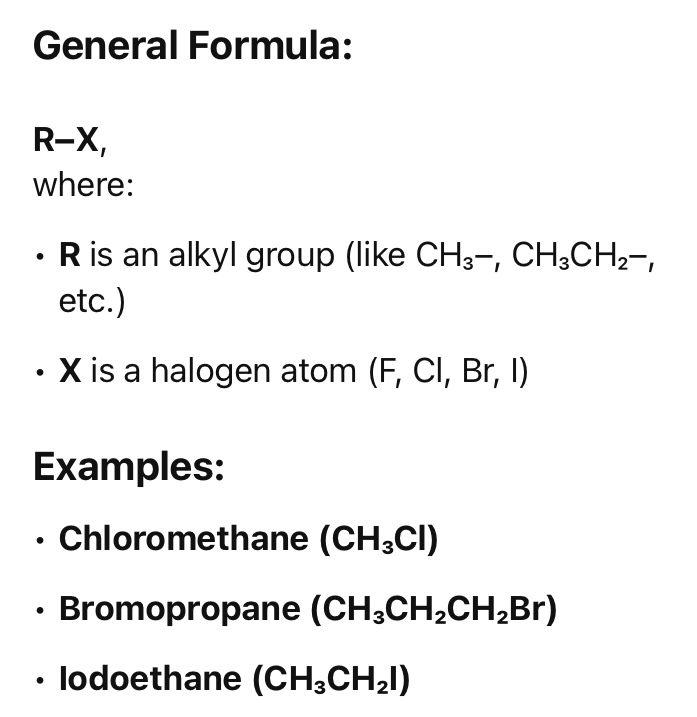UNIT 9 - Alkyl Halides
1/35
There's no tags or description
Looks like no tags are added yet.
Name | Mastery | Learn | Test | Matching | Spaced |
|---|
No study sessions yet.
36 Terms
R-O-R
Ether
ROH, -OH
Alcohol
R-X
Alkyl
What is Alkyl Halides?

It contains one carbon-halogon bond
Alkyl Halide
Give examples of properties and uses of Alkyl Halide
Fire-resistant solvents
Refrigerant
Pharmaceutical and precursors
has one R group attached to carbon linked to the halogen
Primary (1°) halogenoalkanes
has two R group attached to carbon linked to the halogen
Secondary (2°) halogenoalkanes
has three R group attached to carbon linked to the halogen
Tertiary (3°) Halogenoalkanes
Are Halide ions (Br, Cl, I) soluble or insoluble in water?
Halides are INSOLUBLE in water
what happens to the Boiling point if the Molecular weight increase
Boiling point increase
Arrange in order the Boiling point of Halogen (F, Cl, Br, I)
Iodine
Bromine
Chlorine
Fluorine
What is the mechanism of Sn1 and Sn2
Sn1 - two step mechanism
Sn2 - one step mechanism
Explain the mechanism of SN1
SN1 (two mechanism)
Mechanism:
Step 1: Slow, rate-determining step — the alkyl halide dissociates to form a carbocation and a leaving group.
Step 2: Fast step — carbocation reacts with water as a nucleophile — alcohol is the product
Step 3: Proton is loss from the protonated intermediate — forming the neutral alcohol product.
What is the product of SN1 mechanism
Alcohol
Explain SN1 (Substrate, leaving group, nucleophile, solvent)
SN1 (two mechanism)
Substrate:
SN1 reactions are best for tertiary, allylic, benzylic halides
Leaving group
increase reaction = low energy
Necleophile
Nucleophile must be nonbasic to prevent elimination of HX
Solvent
Polar Solvents stabilize the carbocation
Explain SN2 (Substrate, leaving group, nucleophile, solvent)
SN2 (one-step mechanism)
Substrate
SN2 is best for methyl and primary substrates.
Secondary reacts slowly
Tertiary does NOT react
Leading group
Good leaving group (more stable anions)
Solvent
Protic solvents lowers ground-state energy
Nucleophile
Basic
it is:
unimolecular reaction
first order kinetic
2 steps mechanism
rate of reaction: substrate only
forms carbonation
partially racemized
mild nucleophile
high polarity
SN1
It is a unimolecular reaction
SN1
it is:
bimolecular reaction
second order kinetics
rate of reaction: BOTH — Substrate & Nuleophile
only inverted
strong nuclophile
low polarity
SN2
the more highly substituted alkene products predominate
Zaitsev’s Rule
C—X breaks first = removal of proton (what kind reaction)
E1 reaction
what kind of reaction is: C—H & C—X breaks = Alkene in a single step without intermediates
E2 reaction
what kind of reaction: C—H breaks = loses -X = forms Alkene (double bond)
E1cB reaction
Alkyl Halide reaction is also known as…
Tosylate
Which substate does SN2 favors?
Primary and Secondary Substrate
Which substate does SN1 favors?
Tertiary Substrate
What are the 3 mechanisms of Elimination of Alkyl Halides
E1 reaction
E2 reaction
E1cB reactions
short term use form insomnia
Sedation - Chloral Hydrate
anaesthetic agent
Halothane
Give examples of Anaesthetic Agents
Halothane
Flurane
Nitrous Oxide
used as an insecticides
Diclorodiphenyltrichloroethane (DDT)
used as antibiotic
Chloromycetin (Chloramphenicol)
What are the Thyroid Hormones?
T3 and T4
A thyroid hormone:
Thyroxine
4 iodine atoms
Inactive forms
80% of Thyroid hormone production
T4
a thyroid hormone:
Triiodothyronine
3 iodine atoms
Active form
20% Thyroid hormone production
T3